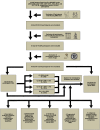Deciphering the Threshold and Segmented Nonlinear Association Between Systemic Inflammation Response Index and Spinal Bone Density: Insights From a Large-Scale Population Study
- PMID: 40396987
- PMCID: PMC12095258
- DOI: 10.1177/21925682251344593
Deciphering the Threshold and Segmented Nonlinear Association Between Systemic Inflammation Response Index and Spinal Bone Density: Insights From a Large-Scale Population Study
Abstract
Study DesignCross-sectional study.ObjectiveTo examine the association between SIRI and spinal BMD and assess the influence of age, hypertension, and diabetes.MethodsWe analyzed data from 13,950 participants aged ≥20 years. SIRI was calculated using neutrophil, monocyte, and lymphocyte counts, and spinal BMD was measured by DXA. Linear regression, generalized additive models, and segmented regression were used, with subgroup analyses based on age, hypertension, and diabetes.ResultsA threshold effect was observed at SIRI = 0.68. Below this threshold, SIRI negatively correlated with spinal BMD (β = -0.0412, P = 0.0494), while above it, a positive correlation was found (β = 0.0079, P < 0.0001). Subgroup analyses showed stronger positive associations in older adults (≥65 years, β = 0.0136, P < 0.0001), and those with hypertension (β = 0.0089, P = 0.0004) and diabetes (β = 0.0187, P < 0.001).ConclusionA segmented nonlinear relationship exists between SIRI and spinal BMD, with age, hypertension, and diabetes as significant modifiers. SIRI may serve as a biomarker for osteoporosis risk.
Keywords: bone health; inflammation biomarkers; osteoporosis; population-based study; spinal bone mineral density; systemic inflammation response index.
Conflict of interest statement
The authors declare no potential conflicts of interest with respect to the research, authorship, and/or publication of this article.
Figures



Similar articles
-
Relationship between systemic inflammatory response index and bone mineral density in children and adolescents aged 8-19 years: a cross-sectional study based on NHANES 2011-2016.Front Endocrinol (Lausanne). 2025 Feb 25;16:1537574. doi: 10.3389/fendo.2025.1537574. eCollection 2025. Front Endocrinol (Lausanne). 2025. PMID: 40070585 Free PMC article.
-
Association of systemic inflammatory response index with bone mineral density, osteoporosis, and future fracture risk in elderly hypertensive patients.Postgrad Med. 2024 May;136(4):406-416. doi: 10.1080/00325481.2024.2354158. Epub 2024 May 16. Postgrad Med. 2024. PMID: 38753519
-
[Association Between the Aggregate Index of Systemic Inflammation and Albuminuria: A Cross-Sectional Study of National Health and Nutrition Examination Survey 2007-2018].Sichuan Da Xue Xue Bao Yi Xue Ban. 2024 May 20;55(3):671-679. doi: 10.12182/20240560108. Sichuan Da Xue Xue Bao Yi Xue Ban. 2024. PMID: 38948283 Free PMC article. Chinese.
-
Non-diabetic elderly populations: SIRI as a risk factor and PIV as a protective factor against bone abnormalities.Front Endocrinol (Lausanne). 2024 Nov 14;15:1467683. doi: 10.3389/fendo.2024.1467683. eCollection 2024. Front Endocrinol (Lausanne). 2024. PMID: 39610846 Free PMC article.
-
Association between systemic inflammation response index and chronic kidney disease: a population-based study.Front Endocrinol (Lausanne). 2024 Feb 22;15:1329256. doi: 10.3389/fendo.2024.1329256. eCollection 2024. Front Endocrinol (Lausanne). 2024. PMID: 38455650 Free PMC article.
References
-
- Voltan G, Di Giovannantonio G, Carretta G, et al. A novel case-finding strategy based on artificial intelligence for the systematic identification and management of individuals with osteoporosis or at varying risk of fragility fracture. Arch Osteoporosis. 2024;19(1):45. - PubMed
-
- Clark P, Calo M, Torres-Naranjo JF, et al. Osteoporosis and fragility fractures in Mexico: a call to action. Arch Med Res. 2024;55(7):103062. - PubMed
LinkOut - more resources
Full Text Sources

